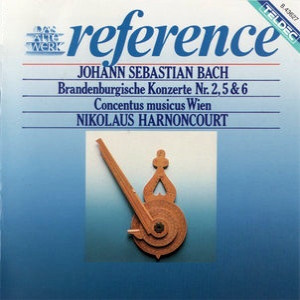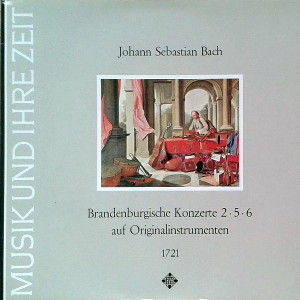 |
| 1 CD -
8.43627 ZS - (c) 1987 |
 |
1 LP -
SAWT 9460-A - (p) 1964
|
|
BRANDENBURGISCHE KONZERTE Nr. 2
- 5 - 6
|
|
|
|
|
|
|
|
|
|
| Johann Sebastian BACH
(1685-1750) |
Concerto
VI B-dur, BWV
1051
|
|
13' 43" |
|
|
|
für
Viola da braccio I, II; Viola da gamba
I, II; Violoncello; Continuo (Violone e
Cembalo) |
|
|
|
|
|
- (Allegro) |
5' 50" |
|
1 |
A1 |
|
- Adagio
ma non troppo |
4' 47" |
|
2 |
A2 |
|
- Allegro |
6' 05" |
|
3 |
A3 |
| Johann Sebastian BACH |
Concerto
V D-dur, BWV
1050 |
|
22' 54" |
|
|
|
für
Flauto traverso; Violino principale;
Cembalo concertato; Violino; Viola;
Violoncello; Violone |
|
|
|
|
|
- Allegro
|
11' 06" |
|
4 |
A4 |
|
- Affettuoso |
6' 02" |
|
5 |
B1 |
|
- Allegro |
5' 46" |
|
6 |
B2 |
| Johann Sebastian BACH |
Concerto
II F-dur, BWV
1047
|
|
13' 42" |
|
|
|
für
Tromba; Flauto dolce; Oboe; Violino I,
II; Viola; Violone; Continuo
(Violoncello e Cembalo) |
|
|
|
|
|
- (Allegro) |
6' 23" |
|
7 |
B3 |
|
- Andante |
3' 45" |
|
8 |
B4 |
|
- Allegro assai
|
3' 34" |
|
9 |
B5 |
|
|
|
|
|
CONCENTUS
MUSICUS WIEN (mit
Originalinstrumenten)
Nikolaus
HARNONCOURT, Leitung |
Concerto VI, BWV 1051
- Kurt
Theiner, Bratsche
(Viola)
-
Alice Harnoncourt, Bratsche
(Viola)
-
Nikolaus Harnoncourt, Gambe
- Ernst
Knava, Gambe
-
Hermann Höbarth, Gambe
- Eduard
Hruza, Kontrabaß
(Violone)
- Georg
Fischer, Cembalo
|
Concerto V, BWV 1050
-
Leopold
Stastny, Querflöte
(Flauto
traverso)
- Alice
Harnoncourt, Solovioline
(principale)
- Georg
Fischer, Cembalo
- Stefan Plott, Violine
- Josef de Sordi, Violine
-
Kurt Theiner, Bratsche
(Viola)
- Nikolaus
Harnoncourt, Violoncello
- Eduard
Hruza, Kontrabaß (Violone)
|
Concerto II, BWV 1047
- Walter
Holy, Clarine (Tromba)
-
Leopold
Stastny, Blockflöte
(Flauto dolce)
- Jürg Schaeftlein, Oboe
-
Alice
Harnoncourt, Spòpvioline
-
Stefan Plott,
Violine
-
Siegfried Führlinger, Violine
- Josef de Sordi, Violine
-
Kurt Theiner, Bratsche
(Viola)
- Nikolaus
Harnoncourt, Violoncello
- Eduard
Hruza, Kontrabaß (Violone)
-
Georg Fischer, Cembalo
|
|
|
|
|
Luogo
e data di registrazione |
|
Schönburg-Palais,
Vienna (Austria) - 31 March / 11
April 1964
|
|
|
Registrazione:
live / studio |
|
studio |
|
|
Producer /
Engineer
|
|
Wolf
Erichson / Dieter Thomsen
|
|
|
Prima Edizione
LP |
|
Telefunken
- SAWT 9460-A - (1 LP) - durata
53' 44" - (p) 1964 - Analogico
|
|
|
Edizione
"Reference" CD
|
|
Tedec
- 8.43627 ZS - (1 CD) - LC 3706 -
durata 53' 44" - (c) 1987 - AAD |
|
|
Cover |
|
Foto mit
freundlicher Genehmigung des
Museums für Kunst und Gewerbe
Hamburg |
|
|
Note |
|
-
|
|
|
|
|
The Brandenburg Concertos were
originally
written, as
modern
research has
established,
for the Köthen
Court
Orchestra, of
which Bach was
conductor. The
instrumentation
of the
concertos
corresponds
exactly with
the
composition of
the orchestra.
The expert
musicians
necessary for
the extremely
difficult solo
parts were
employed here
as "Cammer
Musici": the
violinist
Josef Spiess,
the oboist
Friedrich
Rose, the
flautists
Heinrich
Freitag und
Johann
Gottlieb
Würdig, the
trumpeter
Johann Ludwig
Schreiber.
Horn players,
who were
needed for the
first of the
concertos,
were not
permanently
employed;
there were,
however, often
travelling
horn virtuosos
(always in
pairs) at
Köthen, where
they wished to
be heard. The
gamba was
played by
Christian
Ferdinand Abel
and the Prince
himself the
’cello by
Christian
Bemard
Linigke. In
addition, a
further
violinist and
a bassoon
player were
also employed
as "Cammer
Musici", and
there were
also four
other ordinary
"Musici". We
can thus form
an accurate
mental picture
of the
orchestral
forces Bach
had "in his
ear" when he
wrote the
Brandenburg
Concertos, and
how they were
originally
played.
Much has been
written about
the formal
relationship
of these
concertos to
the type of
the Italian
Concerto
grosso. As in
nearly all
other cases
too, Bach has,
in these
concertos,
made great
changes to the
traditional
form in order
to adapt it to
suit his
ideas. The
contrast
between tutti
and solo is,
of course,
here too the
decisive
element in the
form of the
works; what is
new is the
freedom and
variety with
which these
media are
applied, and
in addition to
conventional
solo passages
accompanied by
the strings or
the continuo,
there are
others in
which all
instruments
are involved
with equal
importance.
Consequently
these stand
out from the
more massive
tutti blocks
only by virtue
of their part
writing and
tone quality.
The
instrumentation,
too, goes
further than
anything know
up till then:
in the First
Concerto we
find two
concerto horn
parts for the
first time in
musical
history, the
Second is the
only work that
has come down
to us in which
a high F
trumpet is
used. The
Fifth is the
first concerto
known to us
for a keyboard
instrument.
There are no
previous
models for the
selection of
instruments
found in the
Third, Fourth
and Fifth
Concertos;
their original
instrumentation,
which goes to
the very
limits of the
possible,
indicates the
importance of
the various
components of
tone character
in the
performance of
these works.
The oldest
stilistic
character is
to be found in
the Sixth
Concerto;
alone its
instrumentation
with only low
string
instruments
recalls the
English
consorts of
viols in the
17th century.
The actual
solo
instruments
are the
violas. We
know that Bach
himself
enjoyed
playing the
viola, and
this is surely
the reason why
he has written
such a
gratifying
double
Concerto for
this typical
accompaniment
instrument,
for which
hardly any
solo
compositions
existed up
till then. By
giving the
middle parts
to gambas he
has avoided
the danger of
thick masses
of tone in
these lower
registers,
which the ear
could not
unravel, V/ith
their bright,
transparent
tone quality,
the gambas
stand out
clearly
against both
the two solo
violas and the
virtuoso solo
'cello part.
Limited to
ostinato
continuo
chords in the
tutti
passages, they
participate in
the play of
motifs in the
solo sections.
In the Fifth
Brandenburg
Concerto, the
earliest known
work with a
concerto part
for the
harpsichord,
all the
technical and
tonal
possibilities
of this
instrument are
employed in
such a
masterly
fashion that
this work
becomes at the
sarne time the
beginning and
the climax of
its category,
The two other
solo
instruments,
flute and
violin, leave
the
harpsichord
the dominant
role in the
first
movement, this
being
underlined by
a
rnagnificently
composed solo
cadenca,
Although the
second
movement is
reserved for
the three solo
instruments
alone, the
contrast
between "solo"
and "tutti" is
strictly
observed: the
tutti passages
are marked
"forte", the
harpsichord
here only
playing the
continuo
accompaniment,
whereas the
solo passages
are "piano"
with the right
hand of the
harpsichord
playing the
most important
of the three
upper parts.
ln the Second
Concerto the
trumpet is
usually
predominant in
everybody's
mind and this
although the
four solo
parts are
musically of
equal
importance in
this concerto
more than in
any other. The
primacy of
place given to
the trumpet
part results
from its
well-known
difficulties
and extremely
high range
and, obove
all, from the
fact that the
modem trumpet
dominates to
such an extent
that this work
must be felt
to be a
trumpet
concerto. At
the same time,
the second
solo
instrument is
a recorder,
the softest of
all wind
instruments!
lt is here
that the
correct
balance of the
original
instruments is
revealed most
clearly. The
natural
trumpet sounds
so soft and
gently that it
never pushes
its way into
the
foreground. On
hearing the
work played
thus, we
realize that
the solo
quartet has
been chosen on
account of the
four entirely
different and
characteristic
tone colours.
Their variety
is
demonstrated
in the solo
passages,
their
wonderfully
colourful
blend when
they play
together.
Nikolaus
Harnoncourt
|
|